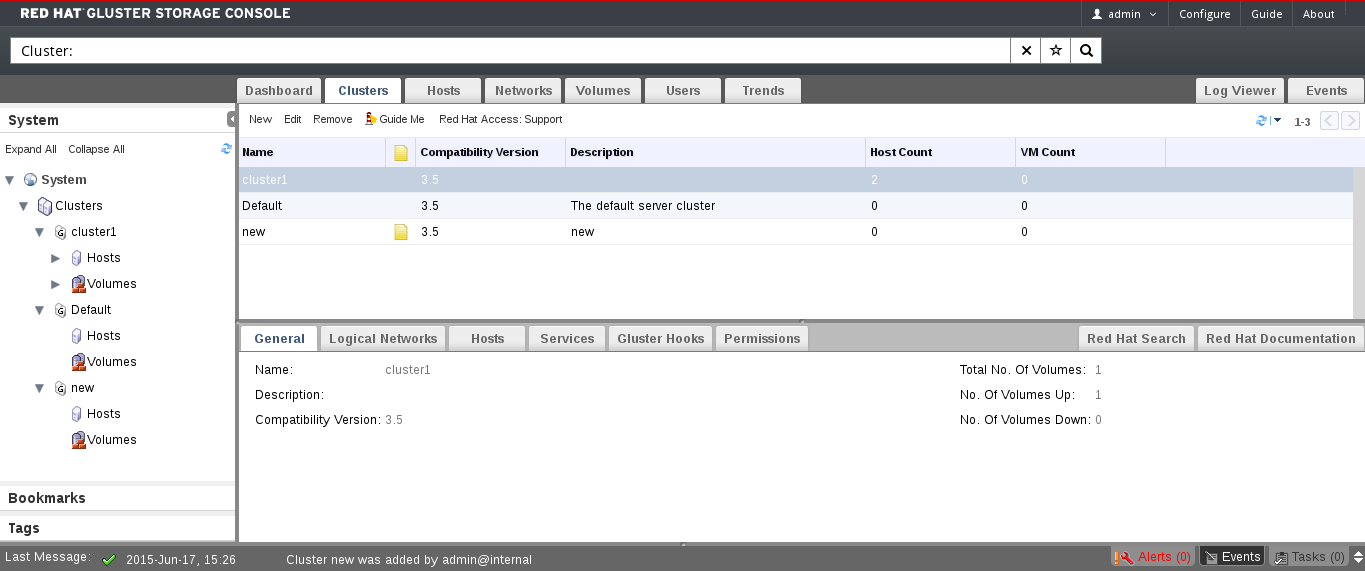このコンテンツは選択した言語では利用できません。
Chapter 4. Managing Clusters
The cluster is the highest level entity for all physical and logical resources within a storage environment. This chapter describes how to create and manage clusters.
4.1. Cluster Properties
リンクのコピーリンクがクリップボードにコピーされました!
Use the Clusters tab in the Administration Portal to define, manage, and view clusters.
Figure 4.1. Clusters Tab
The following table describes the cluster properties displayed in the New Cluster and Edit Cluster dialog boxes. Missing mandatory fields and invalid entries are outlined in red when you click to close the New Cluster or Edit Cluster dialog box.
|
Field
|
Description
|
|---|---|
Name
|
The name of the cluster. This must be a unique name and may use any combination of uppercase or lowercase letters, numbers, hyphens and underscores. Maximum length is 40 characters. The name can start with a number and this field is mandatory.
|
Description
|
The description of the cluster. This field is optional, but recommended.
|
Compatibility Version
|
The version of Red Hat Gluster Storage Console with which the cluster is compatible. All hosts in the cluster must support the indicated version.
Note
The default compatibility version is 3.4.
|
| Feature | Compatibility Version 3.2 | Compatibility Version 3.3 | Compatibility Version 3.4 |
|---|---|---|---|
|
View advanced details of a particular brick of the volume through the Red Hat Gluster Storage Console.
|
Supported
|
Supported
|
Supported
|
|
Synchronize brick status with the engine database.
|
Supported
|
Supported
|
Supported
|
|
Manage glusterFS hooks through the Red Hat Gluster Storage Console. View the list of hooks available in the hosts, view the contents and status of hooks, enable or disable hooks, and resolve hook conflicts.
|
Supported
|
Supported
|
Supported
|
|
Display Services tab with NFS and SHD service status.
|
Supported
|
Supported
|
Supported
|
|
Manage volume rebalance through the Red Hat Gluster Storage Console. Rebalance volume, stop rebalance, and view rebalance status.
|
Not Supported
|
Supported
|
Supported
|
|
Manage remove-brick operations through the Red Hat Gluster Storage Console. Remove-brick, stop remove-brick, view remove-brick status, and retain the brick being removed.
|
Not Supported
|
Supported
|
Supported
|
|
Allow using system's root partition for bricks and and re-using the bricks by clearing the extended attributes.
|
Not Supported
|
Supported
|
Supported
|
|
Addition of RHS U2 nodes
|
Not Supported
|
Supported
|
Supported
|
|
Viewing Nagios Monitoring Trends
|
Not Supported
|
Not Supported
|
Supported
|
